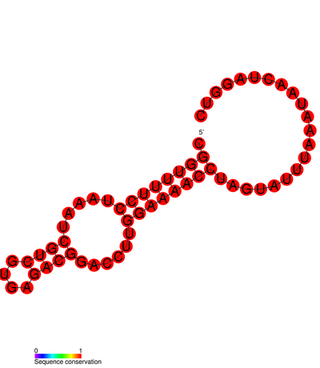
Closteroviridae is a family of viruses. Plants serve as natural hosts. There are four genera and 59 species in this family, seven of which are unassigned to a genus. Diseases associated with this family include: yellowing and necrosis, particularly affecting the phloem.
Sequivirus is a genus of viruses in the order Picornavirales, in the family Secoviridae. Plants serve as natural hosts. There are three species in this genus. Diseases associated with this genus include: PYFV: vein-yellowing, yellow flecks and yellow/green mosaic symptoms in parsnip, and ‘yellow net', followed by yellow spots and leaf distortion in celery.
Tobravirus is a genus of viruses, in the family Virgaviridae. Plants serve as natural hosts. There are three species in this genus. Diseases associated with this genus include: SBWMV: green and yellow mosaic.

Cucumovirus is a genus of viruses, in the family Bromoviridae. Plants serve as natural hosts. There are four species in this genus.

Trichovirus is a genus of viruses in the order Tymovirales, in the family Betaflexiviridae. Plants, specifically angiosperms such as pome fruits, citrus, and pear, serve as natural hosts for this plant pathogen. There are seven species in this genus.

Alphaflexiviridae is a family of viruses in the order Tymovirales. Plants and fungi serve as natural hosts. There are 65 species in this family, assigned to six genera. Diseases associated with this family include: mosaic and ringspot symptoms.
Aureusvirus is a genus of viruses, in the family Tombusviridae. Plants serve as natural hosts. There are six species in this genus.
Avenavirus is a genus of viruses, in the family Tombusviridae. Plants serve as natural hosts. There is only one species in this genus: Oat chlorotic stunt virus.
Brambyvirus is a genus of viruses, in the family Potyviridae. Plants serve as natural hosts. There is only one species in this genus: Blackberry virus Y.
Bymovirus is a genus of viruses, in the family Potyviridae. Plants serve as natural hosts. There are six species in this genus.
Maculavirus is a genus of viruses in the order Tymovirales, in the family Tymoviridae. Plants serve as natural hosts. There is only one species in this genus: Grapevine fleck virus.
Rymovirus is a genus of viruses, in the family Potyviridae. Plants serve as natural hosts. There are three species in this genus.
Tritimovirus is a genus of viruses, in the family Potyviridae. Plants serve as natural hosts. There are six species in this genus.
Permutotetraviridae is a family of viruses. Lepidopteran insects serve as natural hosts. The family contains one genus that has two species. Diseases associated with this family include: infection outcome varies from unapparent to lethal.
Alphanecrovirus is a genus of viruses, in the family Tombusviridae. Plants serve as natural hosts. There are four species in this genus.
Citrivirus is a genus of viruses in the order Tymovirales, in the family Betaflexiviridae. Plants serve as natural hosts. There is only one species in this genus: Citrus leaf blotch virus.
Gallantivirus is a genus of viruses, in the family Tombusviridae. Plants serve as natural hosts. There is only one species in this genus: Galinsoga mosaic virus. Diseases associated with this genus include: chlorotic or necrotic local lesions, systemic mosaic; leaf malformation.
Macanavirus is a genus of viruses, in the family Tombusviridae. Plants serve as natural hosts. There is only one species in this genus: Furcraea necrotic streak virus. Diseases associated with this genus include: macana disease.
Poacevirus is a genus of viruses, in the family Potyviridae. Poaceae plants serve as natural hosts. There are three species in this genus.
Zeavirus is a genus of viruses, in the family Tombusviridae. Monocots plants serve as natural hosts. There is only one species in this genus: Maize necrotic streak virus.



